Back to the NIKA2 run 4 main page
Contents
- March 2016, 15 (Tuesday)
- March 2016, 14 (Monday)
- March 2016, 13 (Sunday)
- March 2016, 12 (Saturday)
- March 2016, 11 (Friday)
- March 2016, 10 (Thursday)
- March 2016, 09 (Wednesday)
- March 2016, 08 (Tuesday)
- March 2016, 07 (Monday)
- March 2016, 06 (Sunday)
- March 2016, 05 (Saturday)
- March 2016, 04 (Friday)
- March 2016, 03 (Thursday)
- March 2016, 02 (Wednesday)
- February 2016, 29 (Monday)
March 2016, 15 (Tuesday)
- Got the telescope from 3:00 to 10:30
- Started with a quick z,x,y,z focus session on 3C279
- zigzag tests on 3C279 at 78, 60, 50, 40, 30 ,20, 10 "/s as requested by Nico.
- OTF with just zig not zag on 3C279
- Kid power test requested by Andrea, changing NIF_tone from 1 to 8
- focus z,x,y,z on Mars on a ring of with 1' around a radius 2'
- beammap on Mars at low elevation, tau betwwem 0.2 and 0.3
skydip just after the beammap. Unfortunately no bright known point source at el>83 and staying there, so backing up to 3c345
- Tau is rising up, still we tried a beammap on 3c345, using the same ring for a quick z,x,y,z focus session before the beammap, reducing the focus was challenging, although a lot of kids must be present it that ring.
March 2016, 14 (Monday)
- Got the telescope from 2:00 to 16:00
- Started with 45 min on RXJ1347-1145 waiting for 3C286 to be below 80deg and allow for polarization measurement
- Switch to polarization at 47 Hz with no crash. Had to restart the acquisition a couple of times
- Focus z,x,y,z on 3C279, tau stable at 0.2
- 3x3 and 5x5 maps on 3C286 nk_rta shows very strange behavior, stopped the HWP to check on a regular pointing scan, similar behavior on the scan taken on the 5th, let's continue...
- Moved to CygA. to do @casa script. beware that the speed might be too slow and thus produce big files... sorry... acqui still with us on 47 Hz (see screenshot on Capture folder on the Desktop on archeops)
- Moved to 3c345 for a quick focus session. U_synchro shows a few random spikes even 5 min after unclick on move and power.
- move to CasA using a modified version of @casa to use the proper speed for the 47 Hz of acqui.
- move to Uranus and did a focus session
- we did a polarisation session on uranus from elevation about 35 to 50 with 4x4 OTF. HWP rotation speed at 4Hz (synchronous with acquisition)
- we move to CygA and scan using cyga_pol.pako
- we move to NGC891 and scan using ngc891_pol.pako (we have only two scans because too high elevation)
- we move to casa and scan using casa.pako (we also did by mistake 4x4 maps of CasA - however we can nicely see the source)
- we end with polar skydip
March 2016, 13 (Sunday)
- Got the telescope from 2:00 to 16:00
- some trouble at the beginning with the acquisition, lots of delays and resonnances not found. restarted all the crate, and all the usb cards, everything back in order
- Focys z,x,y,z on 3C279
- Started deepfield1_loop, tau is between 0.1-0.2
- Good weather for SZ and no planet in the sky: integrating one hour on PSZ1_G046.
- Uranus is up: series of @focusOTF-Z @focusOTF-Y @focusOTF-X (repeated at least twice each - 1 hour)
- Beam map on Uranus with optimum focus corrections
- Skydip
- test proposed by Samuel by focusing on Uranus, computing corrections with pixels in a ring of 2+-0.5 arcmin then beam map on Uranus using these corrections
- last hour: 5x5 otf maps on faint source for NEFD: on PSS2322+1944
March 2016, 12 (Saturday)
- Cryostat fine. Got the telescope from 2:00 to 16:00
- Difficult start of session with loss of resonances, and strange behavior during 'measure'. Fixed by restarting acquisition and all boxes, including a remote reboot of the crate.
- Focus x,y,z on 3c279, realized we need 4h for a focus session and that 3c279 would not be up during the entire session, will wait for 3c345 to be below 80deg after transit
- Started deepfield1_loop x 3, tau stable at 0.15
- Full FOCUS accross the FOV session as requested by Laurence and Jean-François.
- As requested by Nicolas we performed various beam maps at different FOCUS values (the best focus + four more values +-0.5,+-0.1)
- We did a first attempt to the test proposed by Samuel by focusing in a ring of 2+-0.5 arcmin. It did not work very well. We will try to repeat tomorrow.
March 2016, 11 (Friday)
- Cryostat fine. Got the telescope from 2:00 to 16:00
- Difficult start of session with loss of resonances. Fixed by restarting all acquisition
- Focus x,y,z on 3C345
- Almost started deep field, had trouble finding a suitable pointing source, but fog came up.
- complete focus exploration on a 4 x 4 x 4 grid of the focus in x, y, z on Mars. Best value found:
- focus fit z = 0.29 x =-0.26 y =-0.20 from 3D fits
Note that we launched from a single script 64 maps (albeit short) and the >1hr queue went without problem
- focus fit z = 0.29 x =-0.26 y =-0.20 from 3D fits
- Map of HFLS 3 for 45 min (tau from 0.2 to 0.1)
- 10am: Anaelle and Juan take over.
- Good weather for SZ and no planet in the sky: integrating one hour on PSZ1_G046.
- Uranus is up: series of @focusOTF-Z @focusOTF-Y @focusOTF-X (repeated at least twice each - 1 hour)
- Test of @focuslisslong Z on Uranus - corrections not applied
- Beam map on Uranus in good conditions and optimum focus - 1 hour
- Test of velocity/angle effects in zigzag maps: @zigzagtest - 1 hour
We had issues with elvin lagging: inducing tunings in the timelines -> asked everybody to free bandwidth on nika2-a
- OTF maps of 3C84 at different focus in all three directions - 30min
- OTF maps of CXTauGood to secure the 2mm detection / estimate sensitivity with time on faint source - 30min
March 2016, 10 (Thursday)
- Snow storm, no observations
- Early morning, big scare with the cryostat: From Juan email
Early this morning we observed that some of the ethernet connections were not working and that one of the switch did not have power. After some investigation we asked for help to Juan Peñalver who concluded that there was no power on the device (direct measurement). Further we also realized after some tests that the cyrogenic amplifiers have no power neither. Unfortunately the telescope was in staw position and we could not reach the power supply unit. Finally, we also observe that some of the electronic boxes controlling the cryostat were not functioning. Thus, Juan P, and Juan-Luis took the decision to move the telescope in elevation for a few minutes. After some investigation Juan P. found that a cable at the back (quite difficult access) of the box was not connected and reconnected it. This solved the problem. We restarted all the devices. The cryostat has warmed up. Andrea is right not having a careful look to it to restart the cool down.
March 2016, 09 (Wednesday)
* We got the telescope at around 4am (Hervé and Alexandre)
- Always difficult start with resonances.
- focus z, x, y, z on Mars
- Skydip
- otf maps on HFLS3 for 1 hour
* We took over in the morning around 9am (Juan and Anaëlle). Opacity around 0.35 at the begining, rising up to ~1 when we stopped at 3:30pm
- 15 otf maps on PSZ1_G046 (faint extended source)
- A lot of focus/pointing on Uranus but unstable conditions: not very robust results
- Acquisition crashed twiced due to cards failing
- @focusOTF on Uranus: works well except we have to compare the resulting FWHM by hand between the different focus iterations
- At very high opacities but aiming at pipeline test so should be useful: OTF maps on Uranus with different scanning velocities and angle of scanning with script zigzagtest.pro. Done with scan speed 20arcsec/sec and 40arcsec/sec but stopped due to snow
March 2016, 08 (Tuesday)
We could not observe during the night because of bad weather. We started observations after maintenance. Unfortunately, there were first problems with PaKo and then with the telescop due to changes in mrt-lx1. After solving those problems we started normal observations but could not observe planets.
OBSERVATIONS FITH DAY
* We got the telescope at around 6pm after technical time and a few issues with the nika2 disks (disks full)
* We observe from 6pm to 10pm (Juan and Anaëlle) then will get the telescope back at 4am during the night (Hervé and Alexandre taking over)
* Opacity was good (about 0.2 @1mm at 6pm)
- Pointing / focus session on 3C84. Focus X and Focus Y not very stable but found a good Focus Z
- Map of 3C84 at elevation 57°
No more planet in the sky at UT 18: decide to go on faint sources. We observed CXTau (10 mJy at 1mm T-Tauri disk) for about two hours. The source is detected at 1mm and tentatively detected at 2mm. See http://www.iram.es/IRAMES/mainWiki/OffProcNika2Run4 Improved map making to be carried out.
March 2016, 07 (Monday)
OBSERVATIONS FOURTH DAY
- We took the telescope at 02:00. During the first part of the night the opacity was low (about 0.15 @1mm) and the sky quite stable. Then the opacity started to increase slowly until 0.35. In the morning the sky was complete covered by clouds and the opacity increased up to 0.6.
- The acquisition at sampling frequency equal to 47Hz worked for the whole night.
- Main observations today:
* Polarisation:
- 3X3 maps following the quasars 3C286, 3C279, 3C273 (X68)
- 1 skydip with HWP on the beam stopped
- 3X3 maps of NGC7538 (X12)
- for several maps we stored compressed and normal files. At the end of the day we had bad weather and did not observe.
March 2016, 06 (Sunday)
OBSERVATIONS THIRD DAY
- We took the telescope at 11:18 after the snow storm in the night. After heating on the mirrors and pointing close to the sun, still a piece of ice is on the sub-reflector. We are afraid not to observe in best conditions. 5K temperature gradients between primary and subreflector (in normal operations is lower then 1K). After starting, opacity is low but the sky is not stable at all.
- Hard to optimise pointing and in particular focus
- Main observations today:
* Intensity:
- 1 Beam maps (Uranus, telescope speed = 60arcsec/sec).
- 1 skydip without HWP on the beam
* Polarisation:
- 4X4 maps on Uranus (X4)
- All the observations are made at sampling frequency equal to 23Hz.
March 2016, 05 (Saturday)
OBSERVATIONS THIRD DAY
- We started at 5am because of the snow. Then Opacities around between 0.15 and 0.35 (@1mm) during the night/day. Atmosphere not stable during all the observations.
- Main observations today:
* Intensity:
- 2 Beam maps (3C286, Mars).
- About 12 min integration on cluster RXJ1347-1145.
- 3X3 map on NGC7538 (X4 maps) with the HWP on the beam stopped
* Polarisation:
- 3X3 map on 3C286 (X4 maps)
- 3X3 map on NGC7538 (X6 maps)
- 16X16 maps on casA (splitted in three different maps)
- 4X4 maps on Uranus (X19)
- 2 skydips performed with HWP on the beam (the first with HWP on, the second with the HWP stopped)
- Syncronization errors every few minutes when we tried to observe at sampling frequency equal to 47Hz. We switched then to the nominal 23Hz even for polarisation observations. Few synchronisation problem occurred anyway, in particular from 12:00 to 16:00 (probably because many persons worked on nika2 with IDL at the same time).
March 2016, 04 (Friday)
OBSERVATIONS THIRD DAY
- Opacities around 0.25 (@1mm) and 0.18 (@2mm) during the night/day. Atmosphere pretty stable during all the observations.
- Main observations today:
- several maps on secondary calibrators (LKH234,NGC7027,CEPA,CRL2688,MWC349,K3-50A,G45.1,GL490,W3OH).
- Observation of NGC891 in intensity (@nkotf 20 20 -22.5 0 20 40 radec and @nkotf20 20 67.5 0 20 40 radec)
- 1 Beam maps on Uranus (telescope speeds - 78arcsec/s) and 2 beam maps on 3C279 (with telescope speeds - 70 and 60 arcsec/s).
- About 1h10 integration on cluster RXJ1347-1145.
- Second part of focus session.
- Syncronization problems when we try to change the sampling frequency from 23Hz up to 47Hz to observe in polarisation. We are trying to solve this problem, otherwise we keep the nominal sampling frequency for both polarisation and intensity observations.
We observed some secondary calibrators this night. Here are the maps of K3-50A and MWC349 we computed using a first analysis with nk_rta.


We also had the oportunity to observe RXJ1347 for 1h13min before the secondary calibrators became available. The following figure is the S/N map we get from the coaddition of the scans at 2 mm we reduced using a common_mode_kids_out decorrelation method (the dual_band_dec method leaves to much noise on the map so the S/N is reduced). The color bar is not diplayed because the noise properties have not been estimated yet. Therefore the S/N values are wrong. The SZ pic position is consistent with the one measured with the NIKA observations. Such a result is promising given the rather small integration time for an SZ observation !
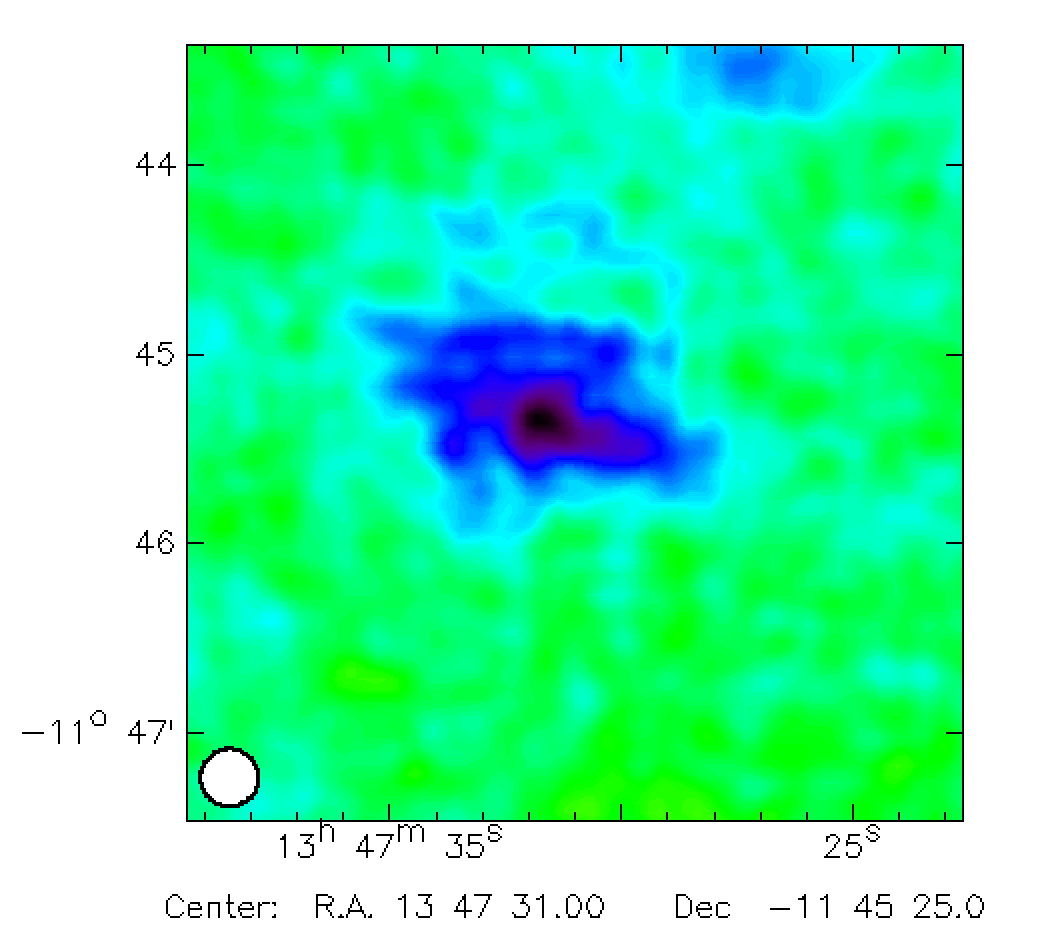
We analyzed the beammaps made on Uranus yesterday morning at two different scan velocities (60 and 70"/sec). The beammaps were made at elevations higher than 30 degrees whereas this previous test realized on Mars on wednesday included a beammap measured at a mean elevation of 15 degree... The first three figures in the following show the results we get from the beammap scan made at 60"/sec (20160303s89_90_91) and the other three show the results we get from the beammap scan made at 70"/sec (20160303s86_87_88). It seems therefore than the scan velocity does not have a significant effect on the beam recovered shape and position in the focal plane. This conclusion has to be strengthened with more statistics so we will repeat this kind of observation tonight.

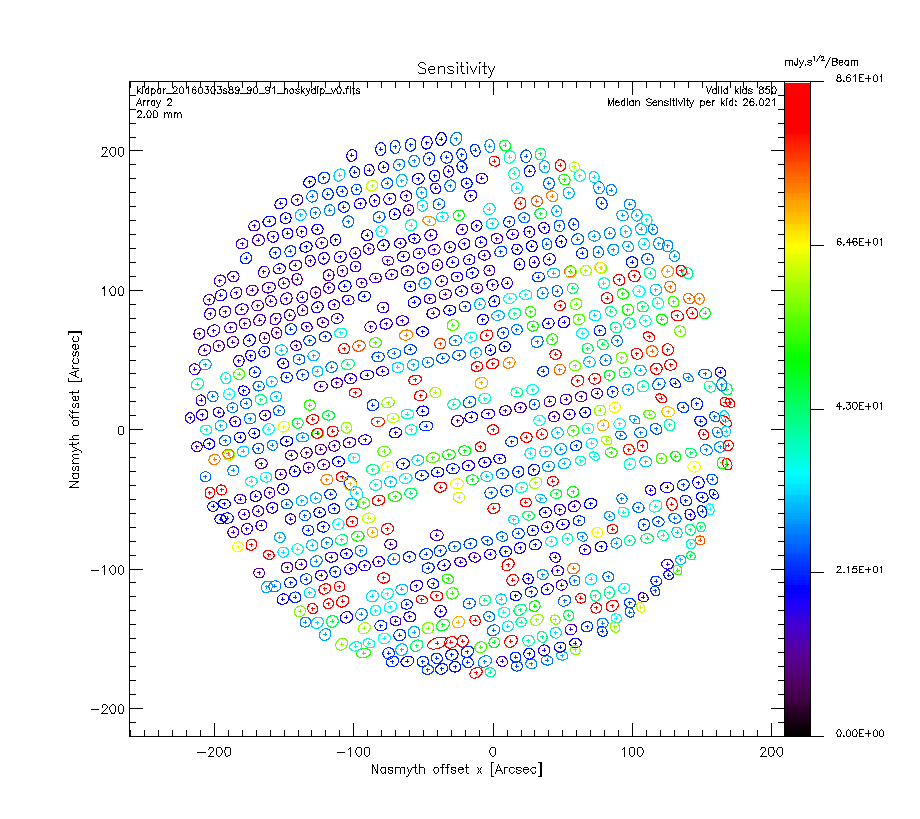
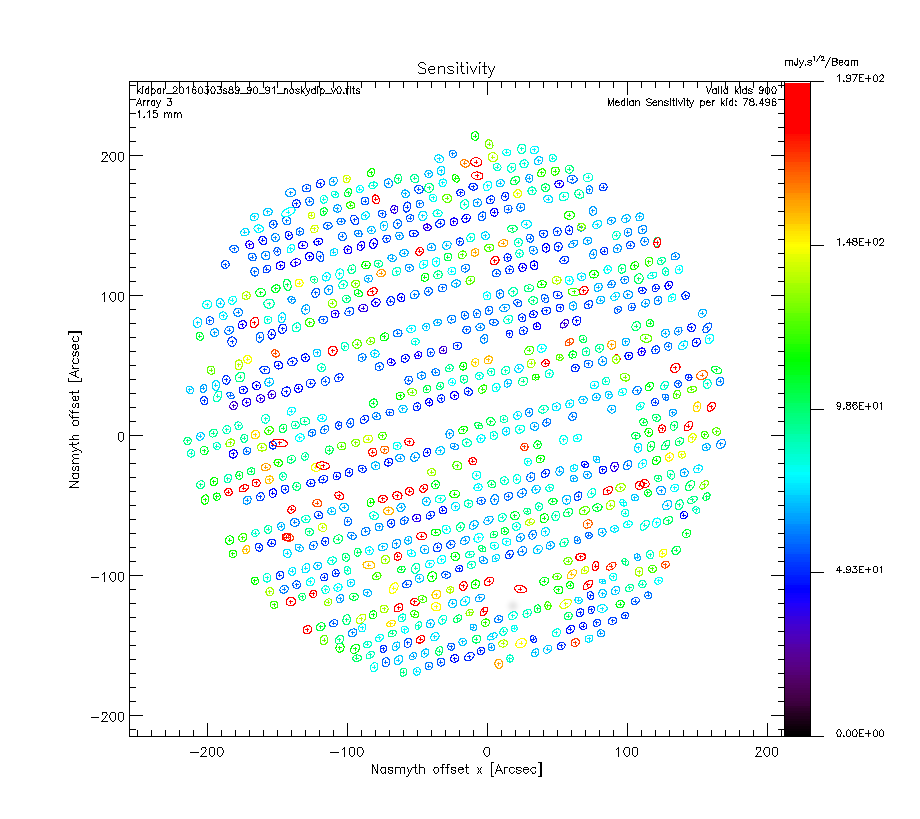
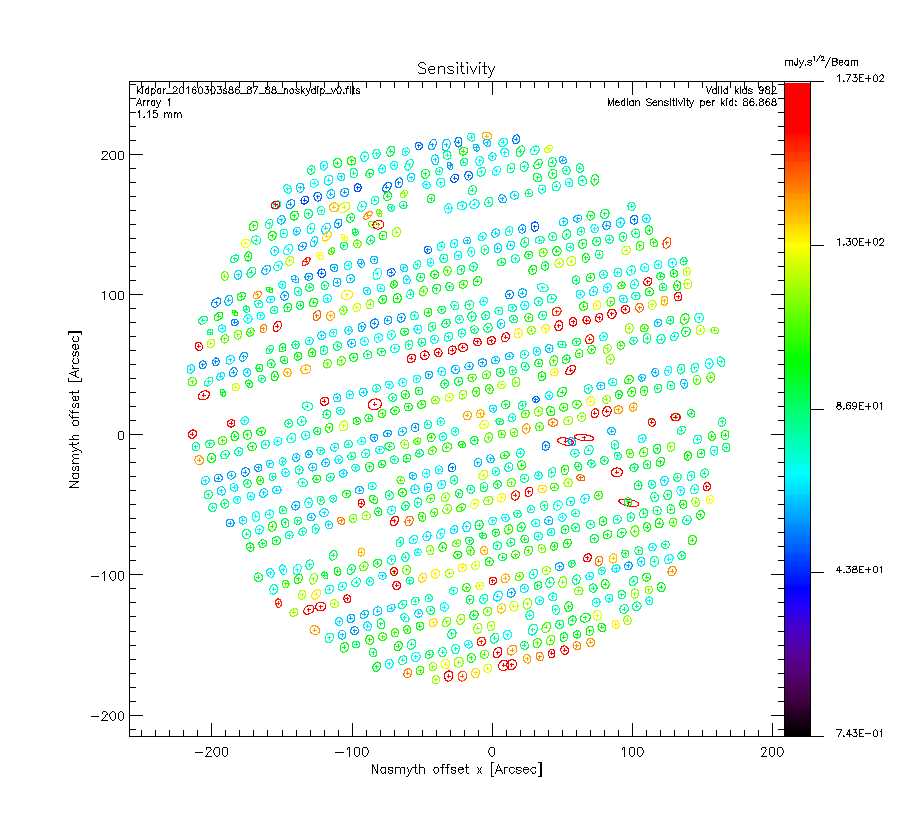
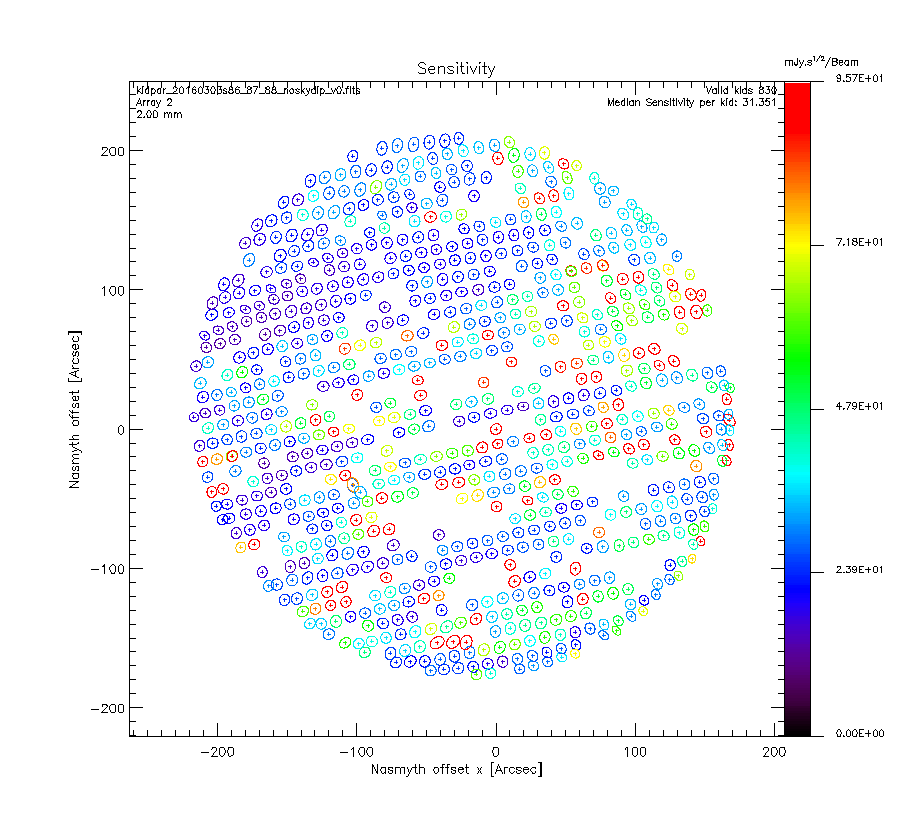
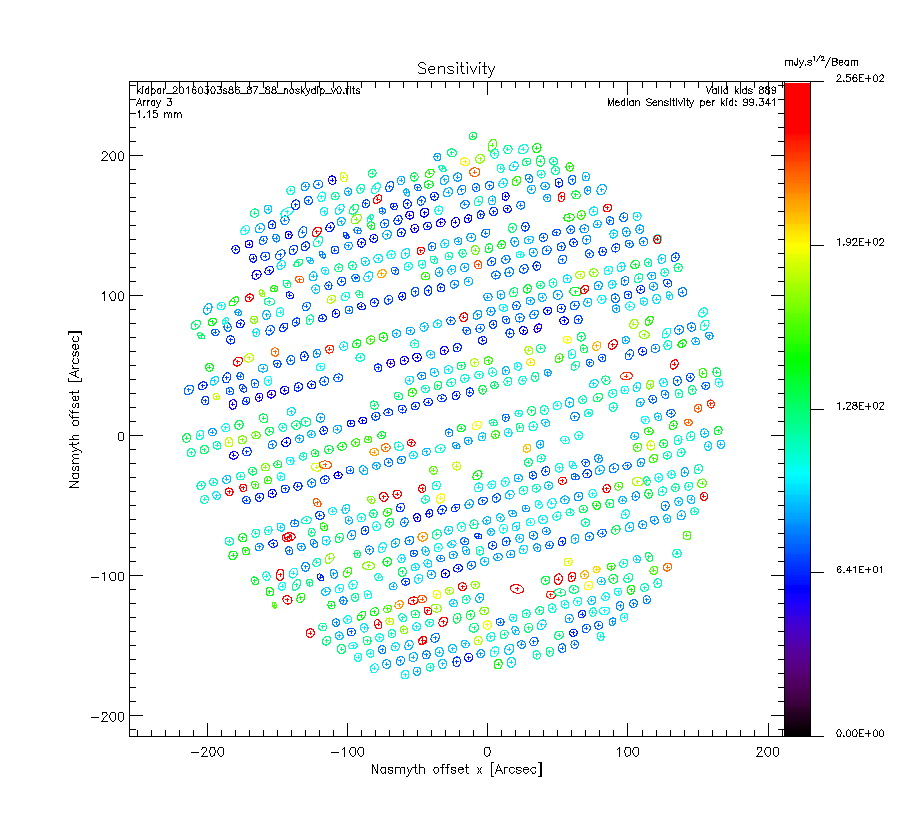
March 2016, 03 (Thursday)
OBSERVATIONS SECOND DAY
- Opacities around 0.35 (@1mm) and 0.2 (@2mm) during the night then increases up to 0.45 at 1mm. Atmosphere pretty stable in the night, much less stable during the day.
- Main observations today: about 4 hours integration on a deep field. 2 Beam maps on Uranus (2 with different telescope speeds - 60arcsec/s and 70arcsec/s). Focus session (mapping the focal plane with small maps on Uranus in order to detect deformations from flatness) - 20 points performed (with some redundancy on the center of the arrays). During the observation of the last 3 of these points a synchronisation problem in the acquisition occurred.
- We got a good skydip 20160303s36 to compute C0 and C1.
We analyzed the first beammap we made yesterday on Mars (scan velocity of 60arcsec/s). As shown on the following figures, two feedlines on array 1 and 3 were very noisy so the recovered sensitivities are quite bad for these KIDs. We get 1014/1140 = 89% valid detectors on array 1, 847/1020 = 83% on array 2 and 918/1140 = 81% on array 3.

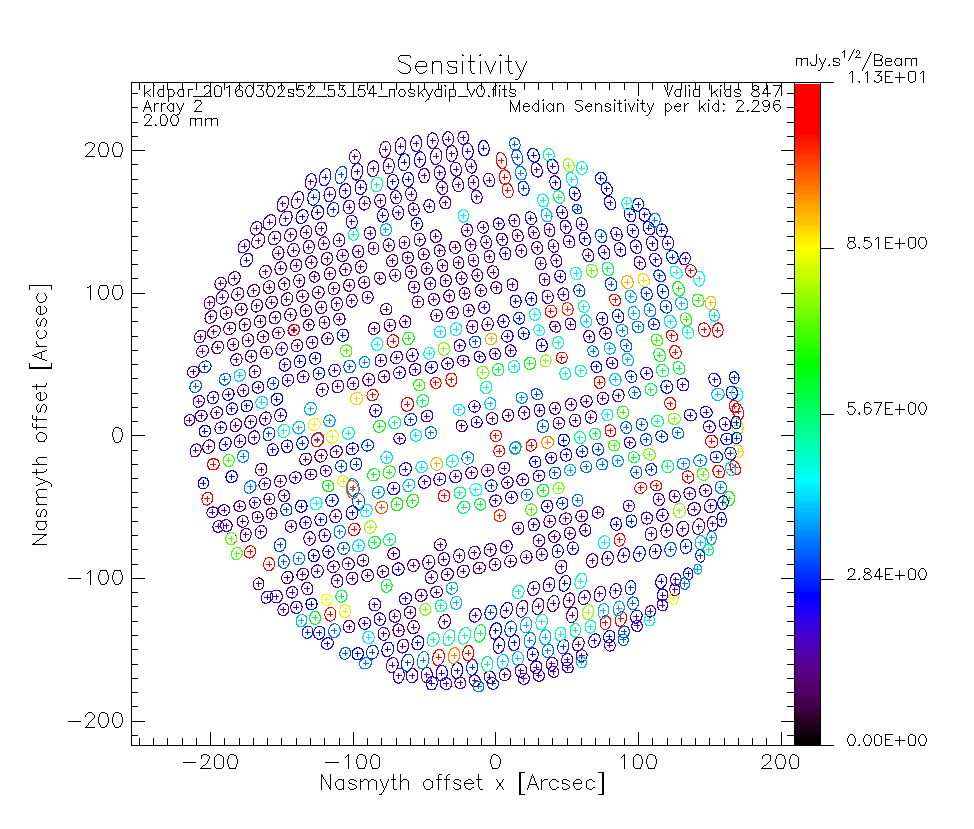
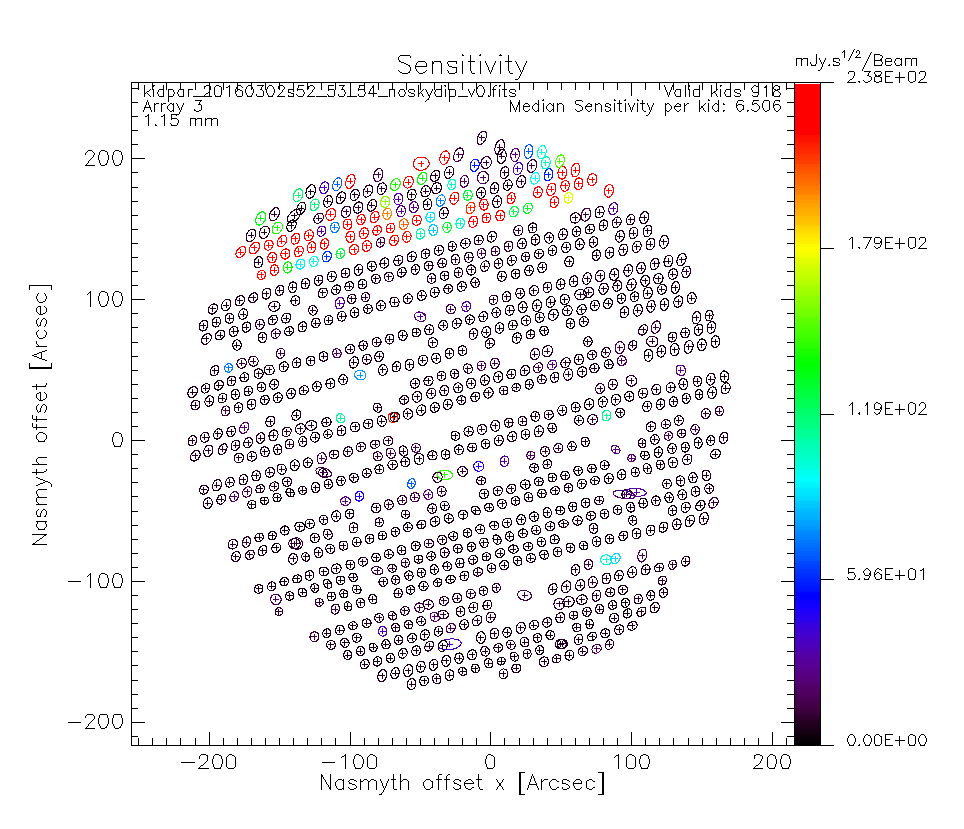
We also analyzed the last beammap made on Uranus. As shown on the following figures there were no more noisy feedline but one electronic box on array 1 was not working during the acquisition. We therefore lost all the corresponding KIDs. We get 875/1140 = 77% valid detectors on array 1, 844/1020 = 83% on array 2 and 906/1140 = 79% on array 3.
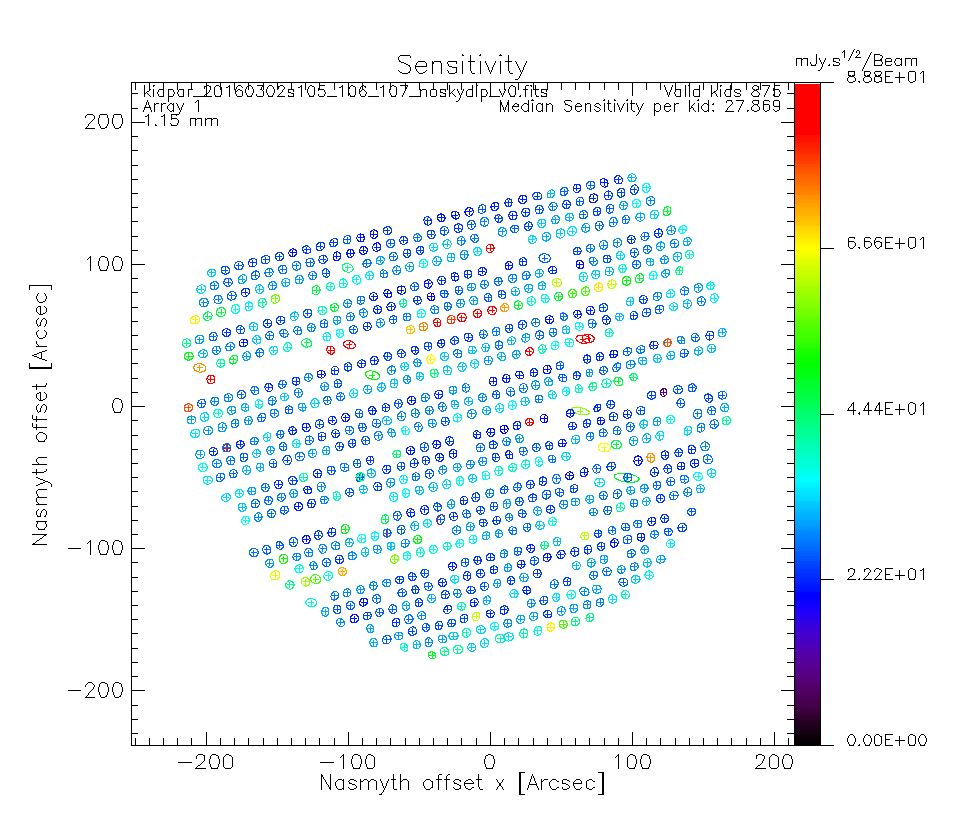
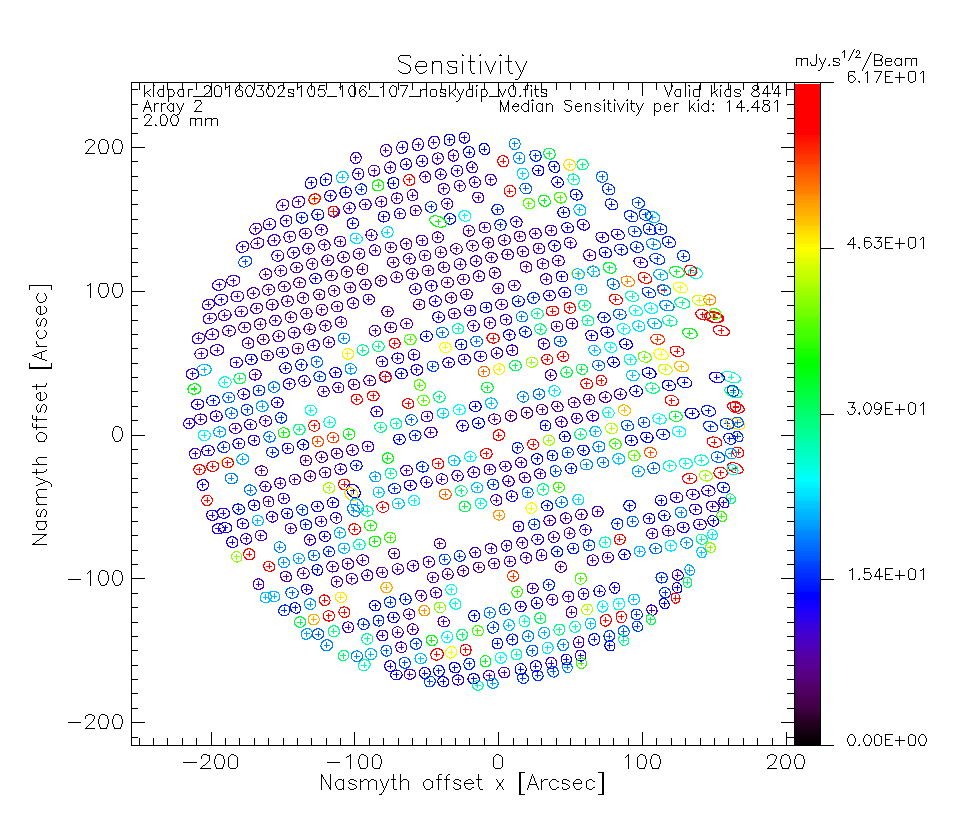

March 2016, 02 (Wednesday)
OBSERVATIONS FIRST DAY
- Opacities around 0.3 (@1mm) and 0.2 (@2mm) during the whole night/day. Atmosphere quite stable as well. Beautiful view!
- Main observations today: about 2h30 integration on faint source (NEP-L about 35mJy@1mm). Beam maps on Mars (2 with different telescope speeds - 60arcsec/s and 70arcsec/s) and 1 on Uranus (with nominal telescope speed 60arcsec/s)
- We got a good skydip 20160302s49 to compute C0 and C1.
- Before each map we performed several pointing-focus-pointing sessions (good boys!)
* 02:00UT We go to the sky for the first time. Clear sky, opacity about 0.2 pretty stable.
The sky noise seems good on the 3 arrays (see the plots below). A little worse on array 3 (1mm NIKEL DC).
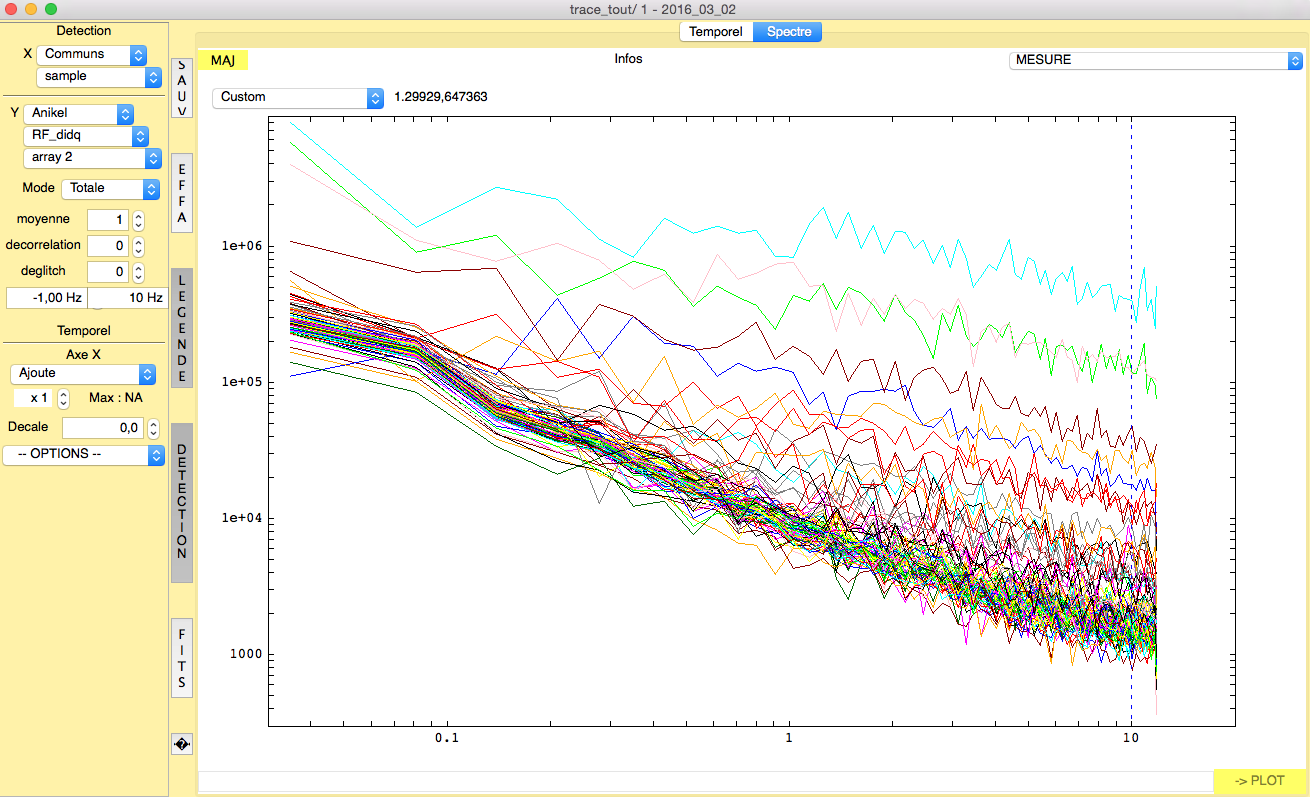
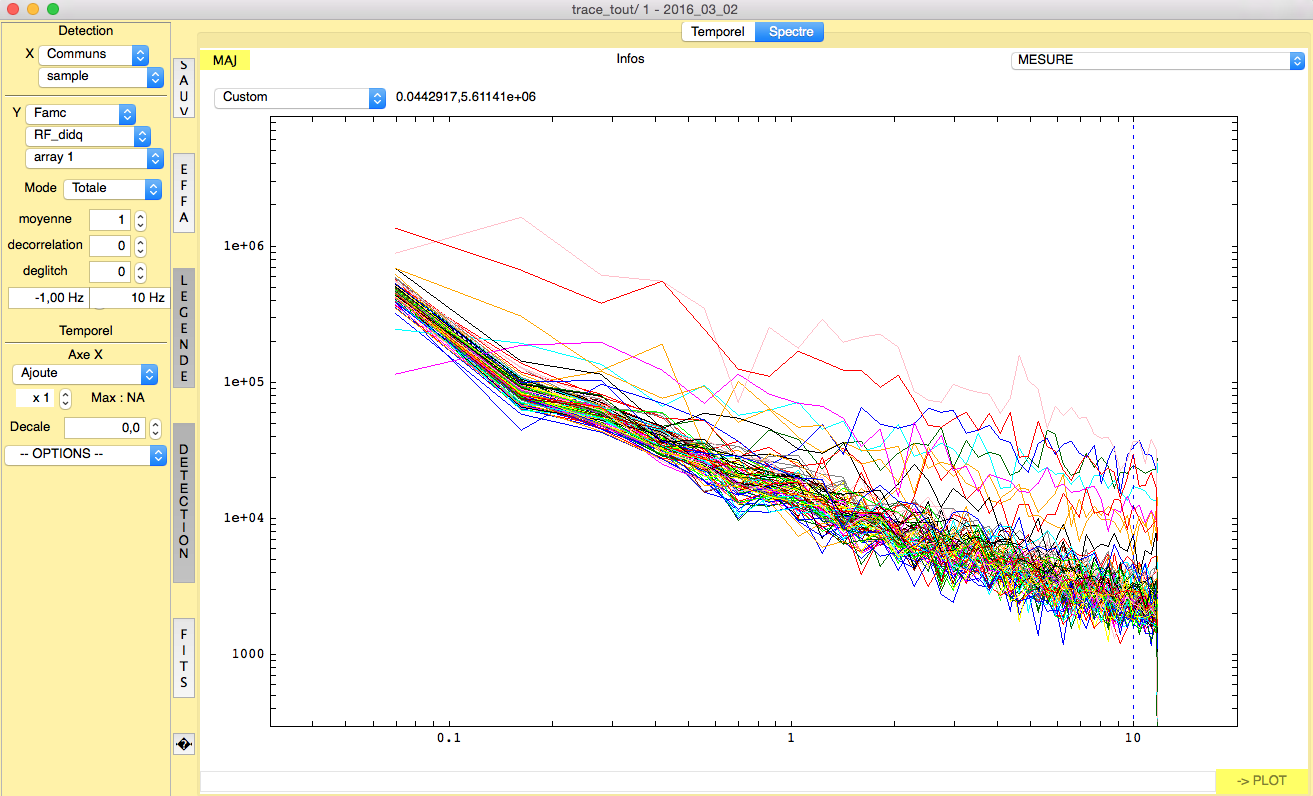
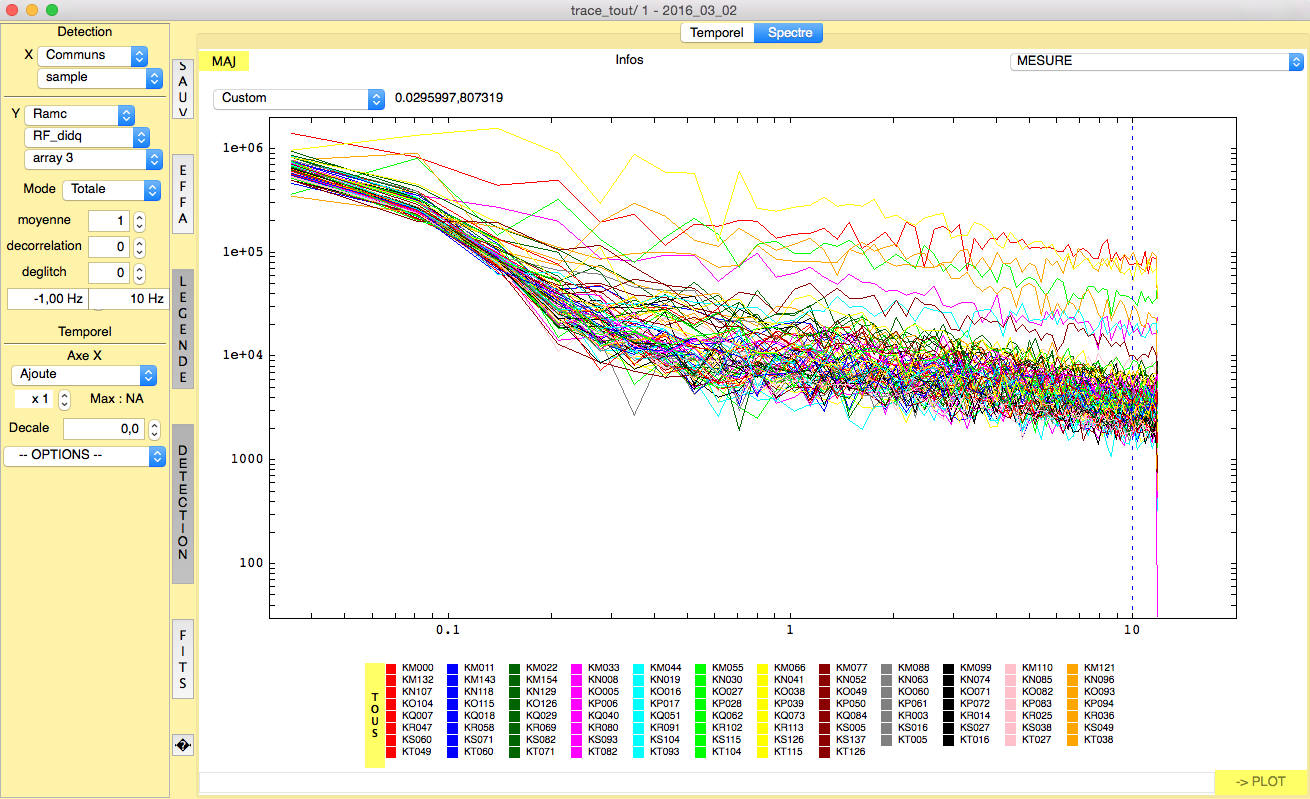
Figure. Noise on the sky for the 2mm, 1mm (array 1) and 1mm (array 3).
* The noise is 1.5Hz/sqrt(Hz), 2Hz/sqrt(Hz), and 3Hz/sqrt(Hz) for the 2mm, 1mm (array 1) and 1mm (array 3) respectively.
February 2016, 29 (Monday)
* Andrea arrived at the telescope.
* Status of the Instrument:
- The cryostat is at the nominam temperature T_100mK=150mK
- All the 20 feedlines are connected.
- The acquisition works nominally (few problems in the morning concerning the ports closed in nika2)
- We are producing normal,compressed and mini file on nika2 and mac12 during the night to check if they are right. First check is ok. We will keep checking tomorrow morning.
- We checked the modulation of the HWP and all the polarisation facilities of nika2. It seems to work nominally.
Hereafter some plot to check the good health of NIKA2:
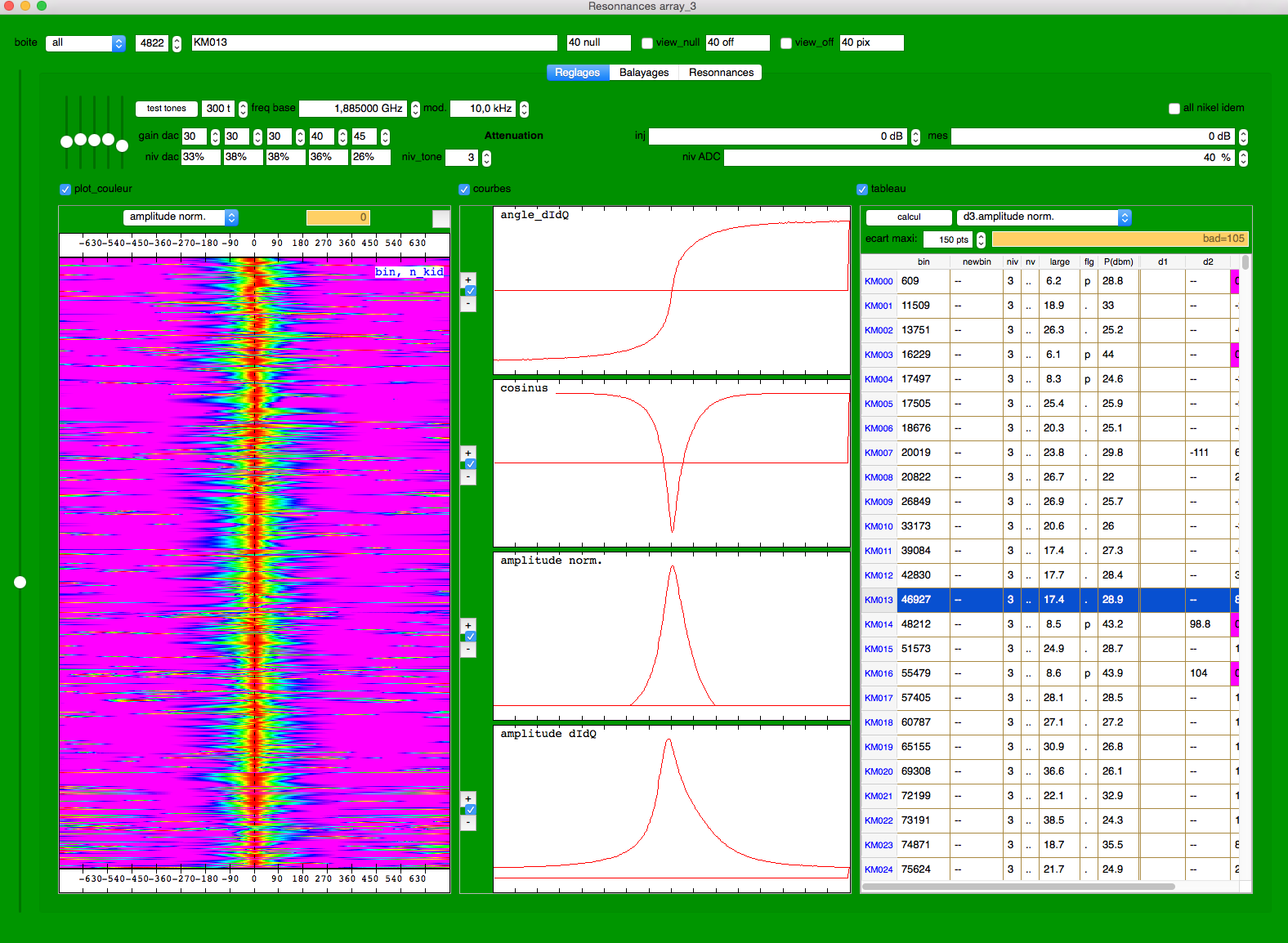
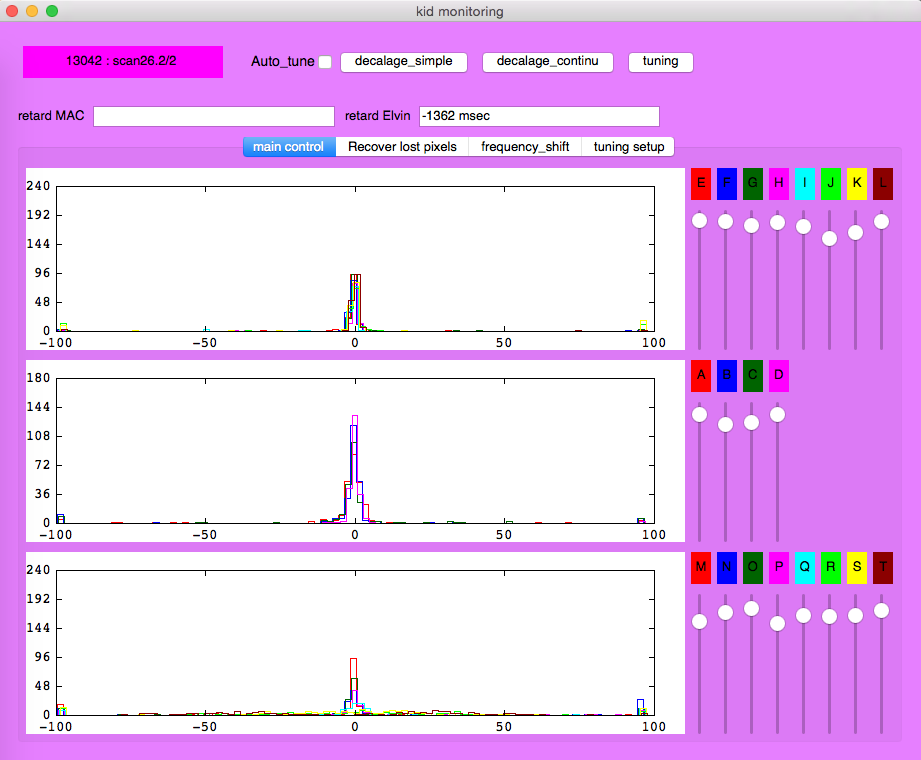
Figure. Left: trace of the 1140 pixels of array 3; right: monitor with all the 20 boards tuned.
THE NOISE is taken with the window on the cryostat. It is in agreement with the previous observing campaign. No traces of the pulse tube.
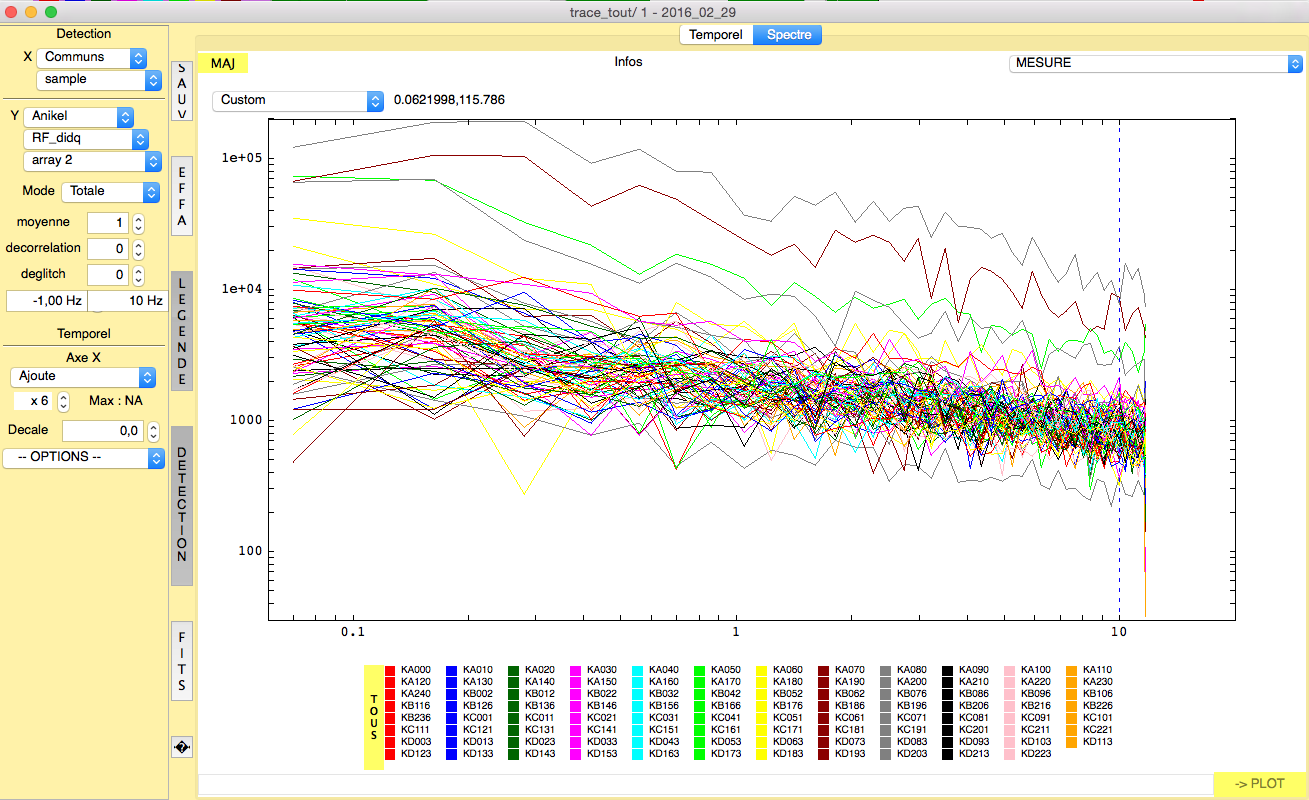
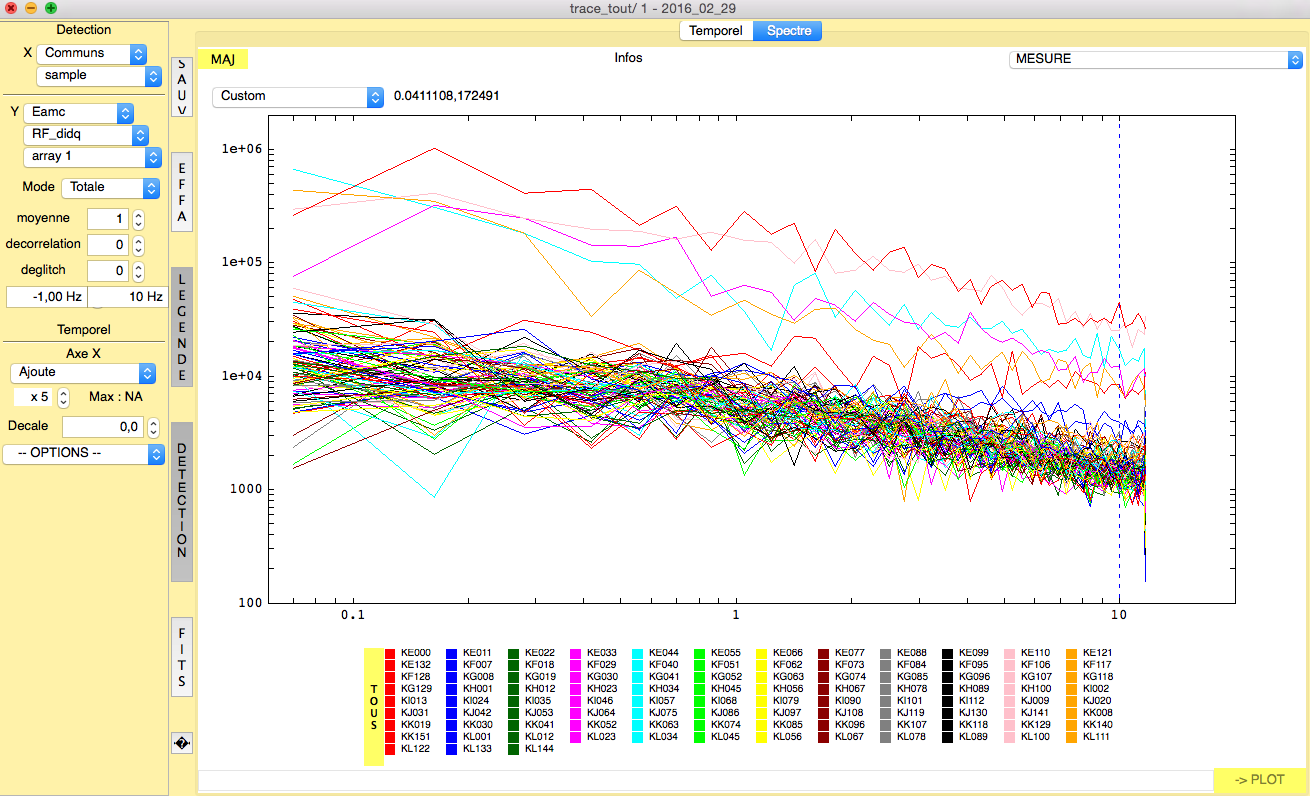
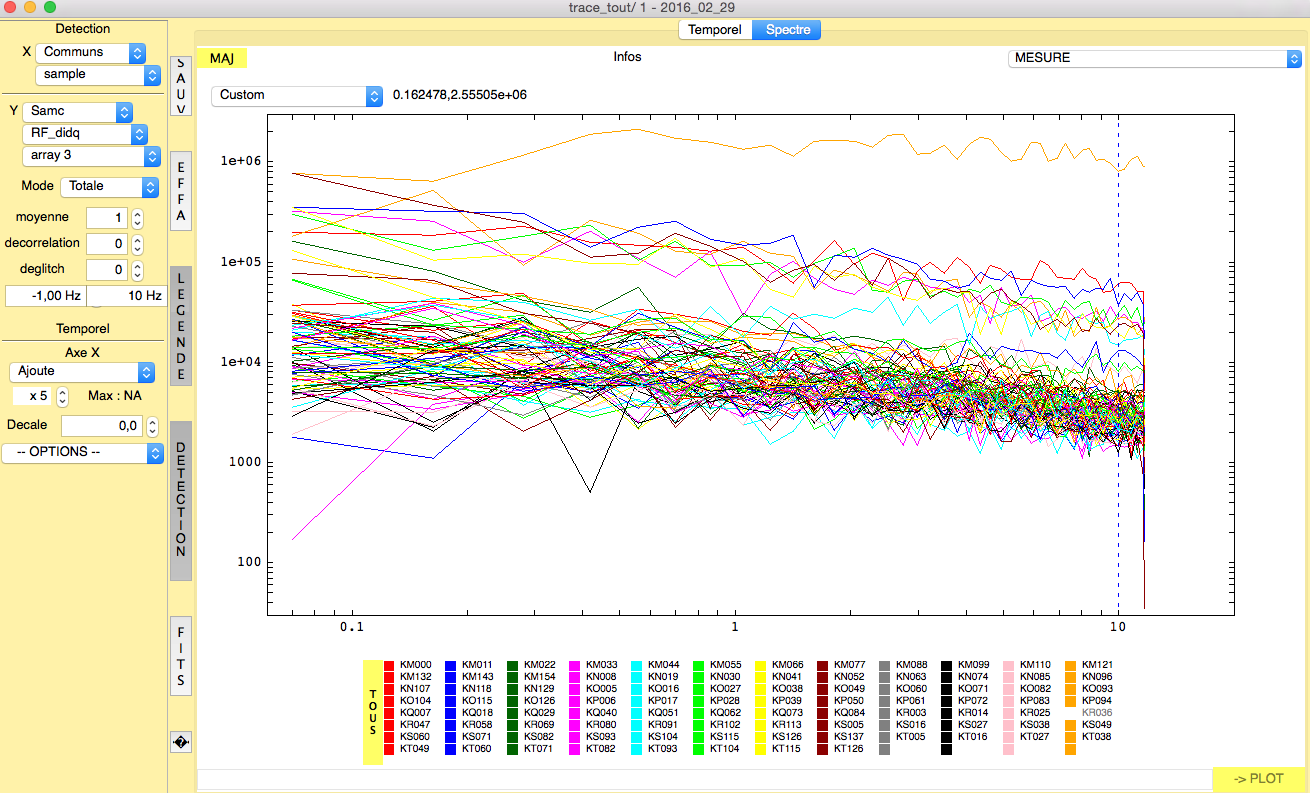
Figure. Noise with the window on respectively the 2mm, 1mm NIKEL_RF (array 1) and 1mm NIKEL_DC (array 3)
